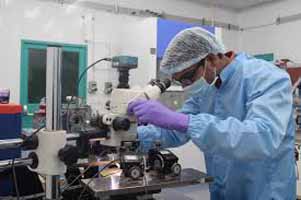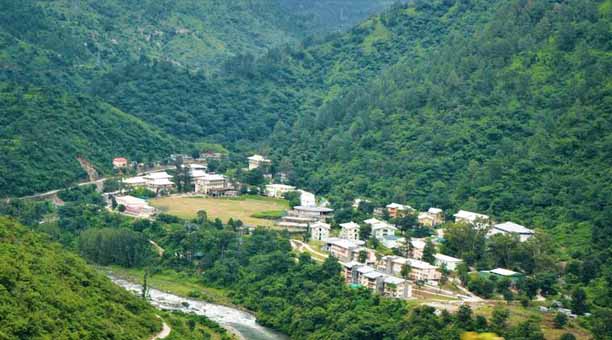MANDI (HIMACHAL PRADESH), JAN 6
Research scholars in IIT-Mandi in Himachal Pradesh have developed new materials that can use sunlight for the production of hydrogen from water. The project has been taken up in collaboration with researchers from Yogi Vemana University, Andhra Pradesh.
The research was undertaken by a team lead by Dr. Venkata Krishnan, Associate Professor, School of Basic Sciences, IIT-Mandi with his research scholars Dr. Suneel Kumar, Mr. Ajay Kumar, and Mr. Ashish Kumar along with Dr. M. V. Shankar and Mr. V. N. Rao of Yogi Vemana University, Andhra Pradesh. Promising results of their recent study has been published in American Chemical Society (ACS) Applied Energy Materials journal.

Speaking about the significance of the research, Dr. Venkata Krishnan said, “With concerns of dwindling fossil fuel reserves and environmental issues associated with their use, there has been an impetus to develop alternative, safe fuels. Hydrogen gas, with its high energy yield and eco-friendliness has been identified as a potential energy vector that can herald a new hydrogen-based economy.”
“The catch with hydrogen economy is that the gas is now largely obtained from fossil fuels by petroleum and natural gas steam reforming processes, which does not help with the problem we set out solving – finding alternatives to fossil fuels,” said Dr. Krishnan.
Water, the simplest chemical compound known to man, is made of two hydrogen atoms and one oxygen atom and is logically a good source of hydrogen. However, splitting water into hydrogen and oxygen is not easy and is energy intensive. It has been known for decades that light can assist in the splitting of water into its constituent hydrogen and oxygen atoms.
Nature already uses light from the sun to bring about all kinds of chemical conversions that provide us today with the air we breathe and the food we eat. Mimicking photosynthesis – the use of light for chemical reactions – has been one of the Holy Grails of applied chemistry and there has been a constant quest for specialized chemicals, called catalysts, that can take the energy of the light to the water to split it, much like the chlorophyll that does it effortlessly in nature.
For a long time, platinum has been used as catalyst for photochemical water splitting, but given the cost of platinum, solar hydrogen generation has been out of practical reach. The researchers have developed a novel multicomponent catalyst comprising nitrogen doped zinc oxide nanorods coated with molybdenum sulphide nanosheets. Materials in the nanometre scale, a scale that is a hundred thousand times smaller than the width of a single human hair, have high surface area-to-volume ratio, improved physical properties and tuneable electronic properties, all of which make them suitable for photocatalytic activities.
“Our optimized heterostructure, made of 15 weight percent of defect-rich molybdenum sulphide nanosheets-coated on the zinc oxide, showed the highest H evolution of 17.3 mmol h−1g−1 under solar light irradiation,” said Dr. Krishnan.
On a technical level, this improvement has been attributed to three facts, viz., the zinc sulphide that is in situ generated during the photocatalysis, the abundantly exposed sulphur edge atoms in defect-rich molybdenum sulphide nanosheets, which has strong affinity for positive hydrogen ions, and the intimate heterojunction formed between zinc oxide and molybdenum sulphide, which facilitates charge transfer efficiency.
This collaborative research work by IIT Mandi and Yogi Vemana University has not only provided an easy method to fabricate the N-ZnO−MoS2 nanosheet heterojunctions but has also offered insights into the scope of exploitation of such materials for hydrogen fuel generation using water and sunlight.
“Our work provides the facile strategy for the rational design of efficient and recyclable photocatalysts for solar-to-hydrogen fuel conversion,” said a confident Dr. Krishnan, on the future implications and potential of their findings.
A decade of creating minds with wings of fire
Since the first batch of 97 students joined in July 2009, IIT Mandi has grown to currently host 125 faculty and 1,630 students who are enrolled in various programmes of studies in undergraduate, postgraduate and research programmes, and 1,135 alumni. IIT Mandi is a fully residential campus with 1,30,000 sq. m. buildings completed. It has a guest house with 88 rooms, an 800-seater Auditorium, campus school, sports complex and hospital.
IIT Mandi has been ranked No. 20 in the Engineering Institutions Category in the India Rankings 2019 released by National Institutional Ranking Framework, Ministry of Human Resources Development, Govt. of India. In the Outreach and Inclusivity metric of NIRF, IIT Mandi is 1st among all 23 IITs.
IIT Mandi has four academic Schools: School of Computing and Electrical Engineering, focusing on the key technologies of the Information Age; School of Basic Sciences, which includes Mathematics, Physics, Chemistry and Life-Sciences; School of Engineering, which engages in research and teaching in core and interdisciplinary areas and branches of Engineering; and School of Humanities and Social Sciences, focusing in Literature, Sociology, History, Economics, Management etc.
Thrust on research and development pays off rich dividends
At present, IIT Mandi’s faculty are involved in 225 R&D projects worth more than Rs. 110 crore. A notable mention is the Advanced Materials Research Centre (AMRC), created in 2013 with an investment of about Rs. 50 crore, housing advanced instruments for characterization of materials. The Institute also hosts a ‘Class 100 Clean Room’ facility, a world-class research centre that is first-of-its-kind in India. In 2017, the Department of Biotechnology, Government of India, selected IIT Mandi to lead the prestigious Rs. 10 crore FarmerZone® Project.
The unique, project-oriented B.Tech. curriculum is centred around its 4-year long Design and Innovation stream. From August 2019, IIT Mandi started 3 new and unique B. Tech. programmes in Data Science and Engineering, Engineering Physics, and Dual Degree in Bioengineering. There are many active MoUs with TU9 Universities in Germany. About 25 students from WPI (Worcester Polytechnic Institute), U.S.A., have been visiting IIT Mandi every year since 2013, along with 2 WPI faculty.
Launched in 2016, IIT Mandi’s Catalyst is the first Technology Business Incubator in Himachal Pradesh. Enabling Women of Kamand Valley (EWOK) is another innovative programme run by IIT Mandi, which focuses on imparting skills training to rural women to enable them to start village-scale businesses.












